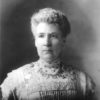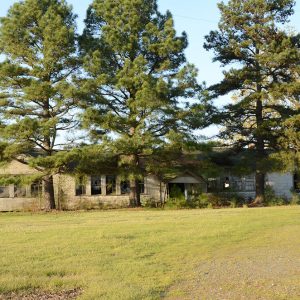calsfoundation@cals.org
Immanuel High School
Located in rural Arkansas County about five miles east of Almyra (Arkansas County), Immanuel High School began as a training institute for formerly enslaved people and their children. Over the decades, the location evolved into a public school that operated until 1966. The building was added to the National Register of Historic Places on January 24, 2007.
Efforts to create an educational institution to serve African Americans in Arkansas County began shortly after the Civil War. Former slaves moved to the area from other states to buy cheap land, joining formerly enslaved Arkansans. They established churches, and these congregations formed the White River District Association of Baptist Churches in 1880. The trustees of the association began working to create a centrally located school, although those efforts took more than twenty years.
The association raised $200 to purchase forty acres of mostly timberland in 1904. The land was cleared and timber sold to generate funds to build a school building. In 1910, the first structure on the site opened. Named the Immanuel Industrial Institute, the main building was a two-story wood-frame structure with classrooms and other communal rooms on the first floor and dormitory space on the second floor for women. Men lived in a nearby cottage. Classes offered by the institute included regular academic coursework, along with vocational training that included broom making, carpentry, and upholstery. To generate income and allow students to earn money to pay for their education, the institute operated a blacksmith shop and broom factory.
The institute closed due to lack of funding during the recession that followed the end of World War I. The trustees of the White River District transferred two acres of the site to the county for the creation of a school district for African American students. This led to the construction of a Rosenwald school at Immanuel in 1927. (The Rosenwald Fund had been created by a Sears, Roebuck and Company executive to help construct educational facilities for Black children in the South.) The original two-story building was converted to a single story.
Operating as Colored District No. 70, the institute continued with support from the White River District until the late 1930s. Several school terms ended early due to a lack of funding. Over the following years, the school term lengthened while the student enrollment fluctuated.
In order to provide more stability for the students at Immanuel, a curriculum based on vocational training, agriculture, and home economics programs was implemented. In support of this program, the district voters approved a six-mill building tax in February 1941. The school also received a $600 loan from the state commissioner of education, with two acres of land as collateral.
The new building was constructed by Ed O’Neal, a resident of the Immanuel (Arkansas County) community, with the supervision of the National Youth Administration (NYA), a New Deal program. The exact date of construction is unknown, but contemporary accounts place it in the early 1940s, after receiving the funds from the building tax and loan.
The U-shaped building includes six classrooms. Clad in white asbestos siding and resting on concrete blocks, the building is topped with an asphalt shingle cross-gable roof. The building, which faces south, also includes a small foyer and an office. A back porch was once attached but was removed after it fell into disrepair.
With the construction of the new building, enrollment grew as nearby districts were consolidated with Immanuel. During the 1948–49 school year, the district counted 357 students. By the 1950–51 school year, enrollment had grown to 506. Further consolidation and new state laws led to the closure of Immanuel in 1966. Enrollment at the school fell below the minimum needed to operate a high school, and the district was officially closed in May 1966. The students in the Immanuel area were then zoned to the DeWitt (Arkansas County) School District.
Over the next several decades, the building was used for various purposes. Boy Scouts and 4-H met at the facility and the Immanuel Christian School operated in the building from 1978 to 1989. Additional groups used the building in the 1990s but by the middle of that decade, the structure was abandoned. The building was added to the National Register of Historic Places in 2007, and historic marker was unveiled at the site of the empty and abandoned school on May 27, 2023.
For additional information:
“Historic Marker Dedicated at Immanuel High School.” Stuttgart Daily Leader, May 31, 2023. https://www.stuttgartdailyleader.com/historical-marker-dedicated-at-immanuel-high-school/ (accessed November 21, 2025).
“Immanuel High School.” National Register for Historic Places registration form. On file at Arkansas Historic Preservation Office, Little Rock, Arkansas. Online at https://www.arkansasheritage.com/docs/default-source/national-registry/AR0280-pdf (accessed November 21, 2025).
Phillips, Thomas, Sr., S. V. Clemmons, and O. B. Elders Sr. “Immanuel Community, 1890–1980.” Grand Prairie Historical Society Bulletin 24 (3/4, 1981): 2–11.
David Sesser
Southeastern Louisiana University







Comments
No comments on this entry yet.